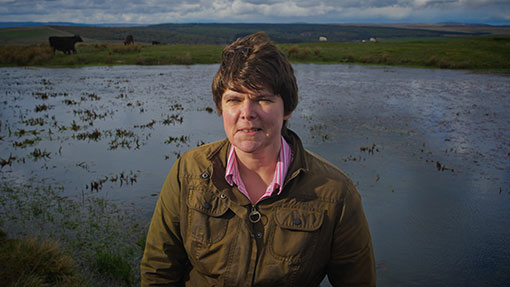OPINION: Monbiot is wrong about sheep

I am having to cut down viewing of BBC’s Countryfile for health and safety reasons. Increasingly, I find it so annoying that I feel a compulsion to hurl a brick through the TV.
In a recent episode, there was a double-headed assault on the humble hill sheep by George Monbiot, described as an environmentalist and newspaper columnist (not phrases that inspire great confidence), and a spokesman from the RSPB (nowadays not a acronym that inspires much confidence either).
I don’t know what Mr Monbiot has against sheep – maybe he has been scarred by eating a dodgy kebab or being forced to wear an itchy woollen jumper as a child. Whatever the cause, he seems to think sheep are the root of all evil. He claimed on Countryfile that due to sheep “all the vegetation in the hills has been removed” and soil has been compacted by sheep hooves, so that the water “flashes” off the hills.
Here is an exchange from the programme:
Monbiot: “The sheep in the hills cause floods in the flood plains.”
Interviewer: “Really. So you’re saying you could put the rising waters in the Severn Valley down to sheep hooves in Wales?”
Monbiot: “Yeah, that’s right”.
Mr Monbiot’s solution is the complete removal of sheep from the hills, together with widespread “rewilding” of the uplands.
Now, if he said there has been overgrazing and sheep numbers should be reduced in some places, I might have agreed with him. But his idea is just ridiculous.
Our hill farm is not overgrazed. The sheep have almost two acres each. They have four little feet and they weigh about 60kg. I fail to see how they could possibly compress the soil to the extent suggested without either round-the-clock tap-dancing, pogoing or hijacking a steam-roller. Indeed, they appear to have done none of those things, as our hill is pretty rough. It is perfectly possible to farm hill sheep in a way that is compatible with encouraging wildlife, and we do.
As to the concept of rewilding – the idea that the landscape would naturally just turn into a wildlife paradise if you simply took the sheep off and ignored it is fanciful. I am reminded of the wise words of Dolly Parton: “It costs a lot of money to look this cheap.”
The ground would have to be managed, otherwise it would end up as messy scrub. And if it had to be managed, it wouldn’t be wild, would it? It would be just another managed landscape. Why would that be better?
The RSPB spokesman on Countryfile implied the black grouse was now thriving in “wild Ennerdale” because there are no sheep.
Well, here’s some information for Mr RSPB. Our farm was once part of an eight-year upland predation experiment on the Otterburn ranges. This involved employing two gamekeepers to control predators such as foxes, stoats and crows to the benefit of not only the black grouse, but also other ground-nesting birds such as skylarks, lapwings and curlews.
The project showed that breeding success was much greater when the predators were controlled. Nearly 70 male black grouse were counted on the range in 2002. However, after the project finished in 2008, they got rid of the gamekeepers and by 2012 the black grouse had completely disappeared.
The sheep, which had been present in modest numbers throughout, had nothing to do with it.
Coincidentally, the protected buzzards, not adverse to attacking birds and birds’ eggs, are thriving around here. Maybe the RSPB should have a think about that.
Elizabeth Elder and her husband Jake run sheep and cattle on 235ha of hill ground on the Otterburn Firing Range in Northumberland.
